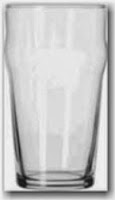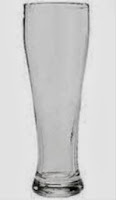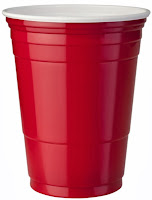Maybe I’m mis-remembering this, but it seems like the evolution of beer has also brought about an evolution of beer glass shapes and styles. I seem to recall going to a restaurant, ordering a beer and expecting it to come out in the standard, regular pint glass. Oh, how times have changed. Here is a handy guide to understand what the different shapes are and the ideal glass for your varying beer styles. NOTE: I do NOT feel that you can ruin a beer by using the improper glass. However, you can use the proper glassware to present the frothy goodness in its ideal form.

There are myriad choices, but most will fall into one of about 8 categories. We will cover all of them here, along with a brief listing of the types of beers best suited for those glasses. Please note that while glasses can be used for marketing purposes, the real value of a proper glass is that it is designed to allow for the right head, smell, look and overall feel of a beer. A hefeweizen is very different from an abbey-style beer and both are very different from an American pilsner. Each will perform best in its own unique vessel.
 The Goblet
The Goblet
Also known as a Chalice, these glasses are designed to allow for optimal head retention. Beers that perform best when the head is ever present (effervescent?). Some can be thin-walled with gold rims and some can be quite ornate with very thick walls.
Best used with: any Belgian beer, Trappist/Abbey-style beers (including dubbel, tripel and quadrupel).
The Mug
Very sturdy and with a nice handle on the side. These can come in all sorts of shapes and sizes, but the main key here is that they are thick, heavy and have that handle. Ideal for clinking glasses together without fear of shattering the glass (worse yet, spilling the contents.) Oktoberfest – beer hall – singing and revelry. General good times. Can also be referred to as a Seidel or Stein (although the Stein usually has a lid that is opened with the thumb.)
Best used with: Just about anything. Again – this is less about science and more about the usability.
The Pint
Do I need to explain this one? Ubiquitous. You probably have a dozen of them at home. Very easy to find, very agreeable to a wide range of beers. But take note of the pint glass in the picture at left – this is an Imperial pint glass. The somewhat wider section toward the top allows head to form in a better fashion. I think one of the great things about a pint glass is that they are very stackable, which makes for great storage.
Best used with: again, this one is the go-to standard, regardless of what you’re enjoying.
The Weizen
You’ve likely seen this one at your favorite pub. You order a Hefeweizen and it is served in this super tall, relatively light weight glass. This glass is one that does not lend itself to many varieties of beer, mainly just wheat beer. The thin walls allow the color to really be on display. The larger, flared opening contains the head and allows for the proper release of the great aromas from wheat beers. A true purist would tell you to avoid the ever-present slice of citrus as it will destroy the head.
Best used with: anything with ‘wheat’ or ‘weizen’ in the name.
The Pilsner
Also known as the Bud Light glass. (Okay, not really. But it could be.) Usually a 12 ounce glass, the slightly closed mouth attempts to capture and preserve the more-rapidly disappearing heads on most lagers. This also helps maintain the carbonation that makes lagers so attractive.
Best used with: any lager, doppelbock, German pilsner, Maibock.
The Snifter
Yes, it’s okay to use your brandy snifter to drink beer. This glass was obviously designed to showcase the great smells from brandy and Cognac. As beers have become more aromatic (and thicker) through the years the snifter has become more and more fashionable as a way to enhance the experience with the thicker, heavier high gravity beers. While you could be referred to as a total beer snob for using this, who cares? The beer going in here probably cost a lot – why not enjoy it to the fullest?
Best used with: the heavy, yummy stuff. Barleywine, double stout, anything Belgian, Scotch ale, and the Trappist/abbey-style beers.
The Tulip
Quick – without looking at the picture, what do you think this might look like? Yes, the funny tulip-shaped glass may look odd, but it serves mainly the same role as the snifter. The slight difference is that the flared lip allows for a bit more head capture. Both are great choices for enhancing the aromas.
Best used with: the heavy, yummy stuff. Barleywine, double stout, anything Belgian, Scotch ale, and the Trappist/abbey-style beers.
<Editor’s note: I prefer the snifter to the tulip, just because there is less chance I’ll spill it on my shirt.>
The Stange
This is less common in these here parts. German for ‘stick’, a stange glass is tall and skinny, with little variation on width from top to bottom. This is best for delicate beers, like a fruit-based beer. I don’t have any of these, and I don’t really see me getting one either. Hard to store and my tastes don’t really align with what this is best used for. To each his or her own.
Best used with: fruit beers, Kolsch.
So there you have it. The eight main categories of beer glasses. Although, I should mention that there is a very important ninth category. And many of you may be fully aware of this one …
I do not see anything wrong with using a red Solo cup when necessary.
 The Goblet
The Goblet








